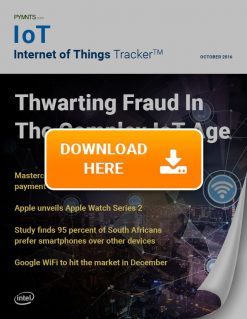Can Tenacious D In The IoT Age Possibly Thwart Fraud?

Last week’s global cyberattack on hundreds of thousands of smart devices set a ginormous spotlight on the vulnerability around IoT. And it has companies scrambling on defense, perhaps more than ever before. The October edition of the Internet of Things Tracker™ features interviews with Randy Vanderhoof of Smart Card Alliance and Accenture’s Willy Dommen about how companies are looking to protect customer data. That, and a directory featuring 74 providers from around the IoT space, in the Tracker.
The recent global distributed denial-of-service cyberattack on hundreds of thousands of smart devices shined a big, booming light on the vulnerability that exists around IoT and security concerns. And in its aftermath, companies are feeling an increased urgency to bolster their security platforms.
Payment security and IoT technology remain an ongoing concern for credit card and smartphone companies, for example, as they explore innovative ways to protect sensitive customer data from cybercriminals.
Before potentially implementing modern security technology, companies have several variables to consider, ranging from cost to scalability. To ward off hackers and fraudsters, some firms launched — or plan to launch — biometric authentication and verification initiatives that mobile device users can use to safeguard their information during the checkout phase. Some of the technologies include retinal scanning and selfie payment systems.
News highlights from the IoT world
By using retinal scanning, for example, Samsung Galaxy Note 7 users are now able to make mobile payments. While the capability is available in the 2.3 version of the smartphone’s software, it’s only offered through the Galaxy Note 7, which is dealing with a significant recall following reports the phone’s battery can explode or catch fire. The phone has also been banned from U.S. flights since its launch during the summer.
Meanwhile, credit card giant Mastercard anticipates launching a selfie payment service in European marketplaces in 2017. Smartphone users will need to download the Identity Check Mobile app before taking a photo of themselves to keep in-app to prevent fraudsters from using their account.
Iovation also delved into the fraud protection area, launching a machine-learning solution that the company claims will help businesses anticipate what transactions will be riskier than others. The solution, called the iovationScore, can pick up on subtle contextual and global behavioral transaction patterns to safeguard consumers from fraud.
Check out the Tracker’s News section for a comprehensive look at what’s happening across the IoT landscape.
For the October Tracker cover story, PYMNTS spoke with Randy Vanderhoof, executive director of Smart Card Alliance, and Willy Dommen, executive for Accenture’s North American regional transportation unit, about how companies are searching for ways to protect customer data at a time when IoT tech devices are connected to seemingly everything.
Here’s a preview:
Given how ubiquitous IoT devices are in today’s marketplace, safeguarding all forms of data is critically important to merchants.
Retail industry merchants don’t just have to protect payment data of their customers for the sake of their own business reputation, Vanderhoof said, but they also must ensure that their customers have a sense of safety and security. For merchants, this is no easy feat to achieve. Many of them struggle to provide security to their customers, especially when they are exposed to innovative technology and new payment solutions, he said.
“Retailers are very concerned when new technology is introduced and offered to consumers,” he said. “They are being hit with a wave of new technologies around payments, and it’s very difficult for retailers to keep up because they’re not in the business of payments — they’re in the business of providing products, goods and a good consumer experience in their stores.”
This often leaves them torn between providing their customers with a relevant and positive shopping experience and offering a range of payment methods that consumers want to use at checkout.
No matter what retailers ultimately choose for their payment and security platforms, there are several variables that need to be taken into consideration, Vanderhoof said.
“What we’ve seen is merchants taking a fairly cautious approach to the innovations that are coming around IoT-connected devices and looking at them very carefully,” he said, adding that retailers take into consideration the affordability of investing in new technology and also determining whether a new payment offering is secure enough to be extended to their customers. “All of those factors go into the retail industry’s view of IoT security architecture and implementation.”
To download the October edition of the PYMNTS.com Internet of Things Tracker™, click the button below…
About The Tracker
The PYMNTS.com Internet of Things Tracker showcases companies that are leading the way in all aspects of the Internet of Things. Every month, the Tracker looks at what these companies are doing across the ecosystem and in six categories: Devices, Infrastructure, Payments, Security, Software and Data.

